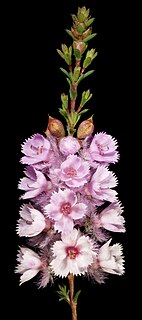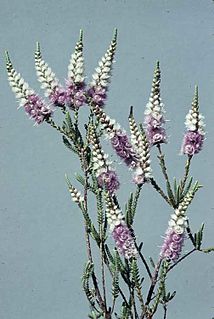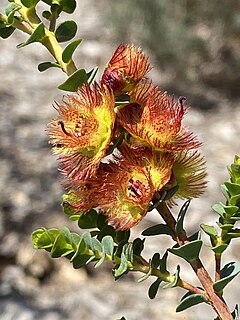Verticordia auriculata is a flowering plant in the myrtle family, Myrtaceae and is endemic to the south-west of Western Australia. It is a small, multi-branched shrub with small leaves and spikes of pink to magenta-coloured flowers in late spring to early summer and it is widespread in the wheatbelt.

Verticordia pennigera, commonly known as native tea, is a flowering plant in the myrtle family, Myrtaceae, and is endemic to the south-west of Western Australia. It is usually a small erect or prostrate shrub with small leaves and lightly-scented spikes of pale pink to magenta-coloured flowers in spring.

Verticordia halophila, commonly known as salt-loving featherflower, or salt-loving verticordia, is a flowering plant in the myrtle family, Myrtaceae and is endemic to the south-west of Western Australia. It is an erect, bushy shrub with small, crowded, thick leaves and spikes of red and pink flowers in spring.

Verticordia spicata, commonly known as spiked featherflower, is a flowering plant in the myrtle family, Myrtaceae and is endemic to the south-west of Western Australia. It is usually a dense, bushy shrub with small leaves pressed against the stem and spikes of pink flowers from late spring to early summer.

Verticordia venusta is a flowering plant in the myrtle family, Myrtaceae and is endemic to the south-west of Western Australia. It is an openly branched shrub with small, egg-shaped leaves and spikes of pink to maroon-coloured flowers in spring and early summer.

Verticordia pritzelii, commonly known as Pritzel's featherflower, is a flowering plant in the myrtle family, Myrtaceae and is endemic to the south-west of Western Australia. It is a compact, woody shrub with several main stems, small, linear to club-shaped leaves, and rounded groups of deep pink flowers from late spring to mid-summer.

Verticordia dichroma is a flowering plant in the myrtle family, Myrtaceae and is endemic to the south-west of Western Australia. It is a much-branched shrub with rounded leaves and spikes of scented, deep red and golden-coloured flowers.
Verticordia jamiesonii is a flowering plant in the myrtle family, Myrtaceae and is endemic to the south-west of Western Australia. It is small shrub with short leaves crowded on young branchlets and white to pale pink flowers in small groups on the ends of branches in early spring.
Verticordia lepidophylla is a flowering plant in the myrtle family, Myrtaceae and is endemic to the south-west of Western Australia. It is usually a bushy shrub with small leaves and spikes of creamish-green to yellow flowers in spikes along the branches in late spring to early summer.

Verticordia lindleyi is a flowering plant in the myrtle family, Myrtaceae and is endemic to the south-west of Western Australia. It is sometimes an openly branched shrub, other times more or less dense, with small leaves and spreading, spike-like groups of pink or purple flowers along the stems in summer, sometimes also in autumn.
Verticordia minutiflora is a flowering plant in the myrtle family, Myrtaceae and is endemic to the south-west of Western Australia. It is a bushy shrub with small, crowded, cylindrical leaves and groups of white to pale pink flowers in summer and autumn. As suggested by its botanical name, it has the smallest flowers of any verticordia.
Verticordia muelleriana is a flowering plant in the myrtle family, Myrtaceae and is endemic to the south-west of Western Australia. It is an openly branched shrub with relatively large, egg-shaped to circular leaves and long spikes of deep maroon coloured flowers in spring and early summer.

Verticordia ovalifolia, commonly known as oval-leaved featherflower, is a flowering plant in the myrtle family, Myrtaceae and is endemic to the south-west of Western Australia. It is an openly branched shrub with egg-shaped leaves and strap-like, feathery petals in spring.
Verticordia paludosa is a flowering plant in the myrtle family, Myrtaceae and is endemic to the south-west of Western Australia. It is an openly branched shrub with small leaves and pink to magenta flowers with spreading, feathery sepals and erect, fringed petals in summer and autumn.
Verticordia pholidophylla is a flowering plant in the myrtle family, Myrtaceae and is endemic to the south-west of Western Australia. It is a shrub with a single branch at the base and many side branches with overlapping yellowish leaves and greenish-white to cream, cup-shaped, feathery flowers.
Verticordia rennieana is a flowering plant in the myrtle family, Myrtaceae and is endemic to the south-west of Western Australia. It is an openly branched shrub with small, narrow, warty leaves and pink and silvery-white flowers in spring and summer.
Verticordia serotina is a flowering plant in the myrtle family, Myrtaceae and is endemic to the north-west of Western Australia. It is a shrub with egg-shaped leaves and bright pink flowers with long, curved styles in spring.

Verticordia tumida, commonly known as summer featherflower, is a flowering plant in the myrtle family, Myrtaceae and is endemic to the north-west of Western Australia. It is an open shrub with very small leaves and clusters of deep pink flowers from late spring to early winter.
Verticordia wonganensis is a flowering plant in the myrtle family, Myrtaceae and is endemic to the south-west of Western Australia. It is a shrub which grows near Wongan Hills and has a single main stem, small leaves and spike-like groups of large, pink, feathery flowers.
Verticordia × eurardyensis, commonly known as Eurardy magenta, is a flowering plant in the myrtle family, Myrtaceae and is endemic to a small area in the south-west of Western Australia. It is a shrub similar to both Verticordia dichroma and Verticordia spicata which grow in the same area and is thought to be a stable hybrid between those two species. It has mostly egg-shaped leaves and spike-like groups of dark magenta-coloured flowers which fade to straw-coloured, in late spring and early summer.








